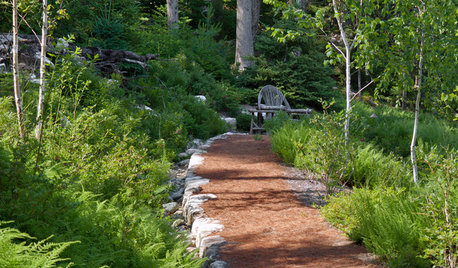Organic Weed Control Methods ~ Mulching
What is Mulch?"
Mulch is a protective covering (such as of bark chips, compost, or grass clippings) overlaid on the ground. Mulch reduces the moisture loss from the soil by preventing evaporation from sunshine and desiccating winds.
Mulch prevents erosion by eliminating or reducing the "splash-away" effect of torrential downpours. Mulch helps regulate soil temperature by shading it in the summer thus keeping it cooler and helps insulate it in the winter from chilling winds. This temperature regulating effect helps encourage the root growth of plants. Mulch helps to keep fruit clean (such as strawberries and tomatoes) by reducing muddy splash-ups during rainstorms. Mulch controls weed growth by smothering seedlings, prevents daylight which helps foster germination from reaching weed seeds, and prevents air-borne seeds from taking hold in the soil surface.
Mulch helps prevent damage to trees and bushes by protecting their stems and surface roots from damage by mechanical garden tools such as weed whackers, edgers, and lawn mowers.
Mulch helps prevent soil compaction by providing a cushion to walk upon. Walking on bare soil will compact it reducing its aeration and ability to drain. Mulch provides a more unified and tidy appearance to flower beds and borders. Mulch helps reduce yardwaste disposal and cash outlay. If you utilize your own yard wastes by chipping pruned branches and limbs, make your own compost, or use grass clippings and raked fallen leaves for mulch you won't have to bag and haul them to the curb for collection or pay for their disposal, you won't utilize land-fill space, and you'll keep your wallet in your pocket because the mulch you create is free. Mulch enriches the soil as it breaks down and releases nutrients back into the ground. Mulch, if not already decomposed, will encourage microbial organisms which are beneficial to healthy plants. ++++++++++++++++++++++++++++++++++++++++++++++++ "What are some common mulches?" Chipped hardwood bark mulch: Is readily available for home-owners from township landfills. It is made from ground and/or chipped trees. It is often free or available at a low cost. The downside of chipped bark mulch from municipalities is that it may contain bark from diseased trees. Compost it for a year before using it in your garden. Before you apply the aged bark mulch topdress your garden soil with fertilizers high in nitrogen such as blood-meal, cottonseed-meal, manure, or guano. Softwood bark mulch: Made from pine, fir, or redwood, is available in many different sizes. It is long lasting and excellent for use in foundation plantings. Compost: Is an excellent mulch that you can make at home by composting various yardwastes such as leaves, grass clippings, plants and soft-wood bush prunings, coffee grounds, and non-animal kitchen wastes. Partially decomposed composted material is one of the most nutrient rich mulches you can use. As it breaks down it releases nutrients into the soil. Crushed Corncobs: Regionally available inexpensive mulch. It is generally available as a dyed or natural product. Corncob mulch is a cushioning mulch and is often used in playgrounds. Hay: Often used in rural and farm gardens because it is more likely to be available at the least expensive cost. The use of aged bales may reduce the weed content. Apply hay mulch after the ground has warmed to discourage mice and voles from tunneling under it. Spent Hops: Available from breweries. Can be a bit "whiffy" after application but the scent will dissipate after a few weeks. Buckwheat Hulls: Buckwheat hull mulch is fluffy and is excellent for use around perennials and annuals. Cocoa-bean Hulls: Cocoa-bean hull mulch is a rich brown color and smells like chocolate-heaven (yumyum!). Apply it in a thin layer as it can otherwise become slimy or moldy. If applied at greater than a three inch depth you may wish to occasionally rake it to stir the hulls about, thus reducing the dampness which fosters the mold. Peanut Hulls: Peanut hull mulch is available from garden centers near peanut growers and processors. As it breaks down it provides some nitrogen to the soil. Lawn Clippings: Grass clippings are best used after they've been allowed to dry. If applied while they're fresh they can compact and generate heat while decomposing. They can produce strong odors the first week or two of decomposition but the scent will subside after that. It is not recommended to use grass clippings from lawns that have been treated with pesticides, fungicides, or herbicides. Leafmold: This mulch is available from most municipal composting facilities or you can make your own. Autumn gathered leaves left to decompose over winter will provide you with leafmold ready for use the following spring.
Fallen Leaves: The least expensive form of mulch available. It is readily available in Autumn near woody areas. Fallen leaves may be used as is, chopped with the lawn mower to reduce their size, or compost them during winter and use them as leafmold the following spring. Manure: Available as a bagged commercially composted product at garden centers, or available fresh from stables and farms. Fresh manure should be composted for at least six months to reduce nitrogen burn when applied around plants and to reduce the viability of weed seeds in the manure itself. Mushroom soil/compost: Is available at garden centers or sources near commercial mushroom growers. It is generally inexpensive. Peat Moss: A commonly used mulch, it is attractive when applied thickly. Look for course-grade peat moss when using it for a mulch. It can be cost prohibitive when used for mulching large areas. Peat moss will shed water when it's dry rather than absorbing it. You can help maintain it's moisture by watering this mulch regularly when you also water your lawn. Pine Needles: Are a light colored, fluffy, and pretty mulch. Leave them in place under pine trees rather than removing them. Rake them from your lawn grass and use them to mulch around acid-loving plants such as azaleas, blueberries, and rhododendrons. They are also excellent to use as a cushioning mulch for garden paths and will release their pine scent when walked upon. Sawdust: Available from timber mills or other wood processing businesses. As it decomposes it can cause nitrogen loss from the the soil so if used in garden beds apply nitrogen rich fertilizers regularly. Sawdust is an excellent mulch for garden paths. It is not recommended to use sawdust from chemically treated or painted wood. Straw: Can be used for winter protection as an overlay in muddy areas and will provide some traction on icy paths. It is also frequently used as a mulch in veggie gardens. Do not use straw mulch in frequently used areas as it is highly inflammable. Do not use it to mulch walkways as it can be easily ignited by a carelessly tossed smoldering cigarette butt. Wood Chips: Can be obtained from arborists, utility companies, municipal yard waste facilites, and garden centers. They are very long lasting and make a good overlayment for paths and walkways. To learn more about mulch and the wonderful effect of compost and micro-organisms in the soil please visit the "Soil, Compost, and Mulch Forum" and do read their fabulous FAQs. Taking care of your soil is vital to having a garden of healthy and vigorous plants.













Related Discussions
Seriously--weeds, organic methods v.s. Roundup?
Q
Organic Weed Control
Q
Best weed control method for my situation?
Q
Organic Weed Control Methods ~ Hoeing
Q